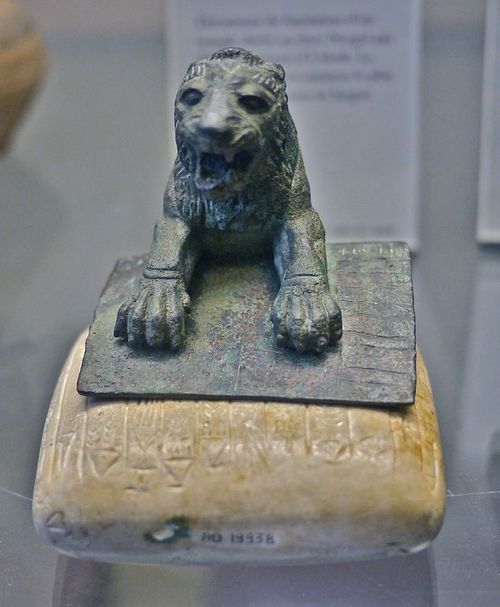Recently, a team of Kurdish and German archaeologists discovered a 3,400-year-old palace in Iraq. The discovery was possible because of the reduced water levels in the Mosul Dam reservoir on the banks of the Tigris river due to Iraq’s drought. According to the team, the palace remains are of the Mittani Empire, one of the greatest yet the least researched empire of the ancient east.
So, what does the world know about the Mittani Dynast?
Mittani
Empire – Origin and Background
The Mitanni dynast ruled between c. 1475 and c. 1275 BCE over the land of the Hurrians in the northern Euphrates-Tigris region (currently part of Syria, northern Iraq and South-Eastern Turkey). The Mitanni kings were Indo-Iranians who formed a ruling class over the Hurrians. At the height of their dynastic power, Mittani territory extended all the way to the Assyria / Mesopotamia on its southeast and the Mediterranean coast on its west. The influence of Mitanni was so strong, that at one time, it was part of the ‘Great Power Club’ encompassing Babylonia, Assyria, Egypt and the Kingdom of Hatti. To the Assyrians they were Hanigalbat and the Egyptians identified them as Metani and Nahrain.

The capital of Mitanni Wassukanni and the important cities Kahat and Taide have not yet been identified, but it is believed that they must be somewhere in the southeast of Turkey or east of modern Syria.
The Rise of the Mitanni
Going by the limited available resource the rise of the Mitanni occurred exactly when the Old Babylonian Empire started declining. The weakening of the Babylonians gave a lot of opportunity to the Mitanni to expand its empire. However, according to the alternate story, the destruction of Aleppo and Babylon allowed new states to arise which laid down the foundation of the Mitanni. Very little is known about the early kings of Mitanni. Perhaps, the records would have later been destroyed by the triumphant Assyrians. However, due to the correspondence of the Mitannis with the foreign powers, we have an access to the list of the Mitanni rulers.
Kirta (c.1500 – 1490 BC)
Shuttarna I (c.1490 – 1470 BC)
Parshatatar (c.1470 – 1450 BC)
Shaushtatar (c.1440 – 1410 BC)
Artatama I (c.1410 – 1400 BC)
Shuttarna II (c.1400 – 1385 BC)
Artashumara (c.1385 – 1380 BC)
Tushratta (c.1380 – 1350 BC)
Artatama II (c.1380? – ? BC)
Shuttarna III (c.1350)
Shattiwaza, Matiwaza or Kurtiwaza (c.1350 – 1320 BC)
Shattuara (c.1320 – 1300 BC)
Wasashatta (c.1300 – 1280 BC)
Shattuara II (c.1280 – 1270 BC)
Mitanni Empire History – From
the Early Days to their Decline
The initial years of the Mitanni empire especially Kirta, the founder king who shaped the empire mostly revolved in the struggle with Egypt, the then superpower to get control over Syria. The greatest Mitanni king was Shaushtatar (c.1440 – 1410 BC) who reigned during the period of Tuthmosis III – The Sixth Pharaoh of the 18th dynasty. He not only looted the Assyrian palace at Ashur but also reduced the power of Assyria. Under the reign of Artatama, friendly relations were established between the Egyptians and the Mitanni. The daughter of King Artatama was married to Tuthmosis IV. Later, the daughters of Shuttarna II (Gilukhipa) and Tushratta (Tadukhipa) were married to Amenhotep III.
Tushratta (c.1380 – 1350 BC) was the last independent monarch of the Mitanni Empire. Weakened by internal conflict and isolated by their Egyptian allies, the kingdom of Mitanni became a pawn in the power games of the Assyrians and the Hittites. During Tushratta’s sovereignty, the Hittite king Suppiluliumas took control over the Mitanni capital Wassukkani. It was in this chaos Tushratta was assassinated. Tushratta’s successor Artatama II (Brother of Tushratta and his rival claimant), gave up on Egyptian aid and instead signed a treaty with the Assyrians.
Suppiluliumas however removed that threat by replacing Artatama with Tushratta’s son Kurtiwaza aka Mattiwaza. Next, he became the king of the new vassal state of the Hittites, which was then called Hanigalbat. However, soon afterwards, Hanigalbat was captured by the Assyrian Adad-nirari I (perhaps during the time of Horemheb) and thereafter by Shalmaneser I (during the period of Ramesses II). Following this, the entire east of the Euphrates was turned into an Assyrian domain, putting an end to the Mitanni Empire.
Administration, Culture and Living
Like the Vedic people, the kingdom of Mitanni was a feudal state led by a warrior nobility of Hurrian or Aryan origin. The upper class comprised of maryannu, a chariot-warrior caste, the one that bred horses on large country estates. The nobles received their land but as an inalienable fief meaning they could not sell their land. Textiles were exported to foreign markets. The legal system and social structure were well-organized and patterned after the Babylonian.
Few Mitanni settlements have been uncovered in Mesopotamia which exhibits that there were large palaces even in small district capitals for the ruling house. These palaces were decked with frescoes. Small temples have also been found. The dead was supposedly buried outside of the townships. The Mitanni worshipped the same gods as those in the Rig Veda along with their own local ones. How do we know? Well, they signed a treaty with a rival king in 1380 BC and it names names Indra, Varuna, Mitra and the Nasatyas (Ashvins) as divine witnesses for the Mitannis.
Source and Reference:
Mesopatamia: The Mitanni (Naharin) Empire
The Aryan God of the Mitanni Treaties by Paul Thieme
.

